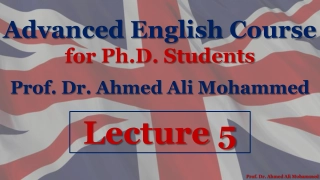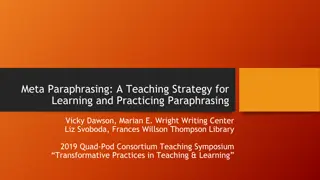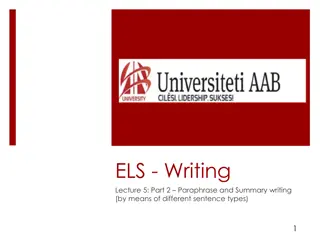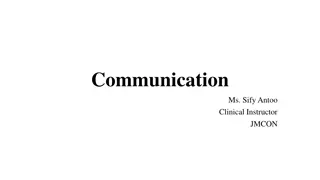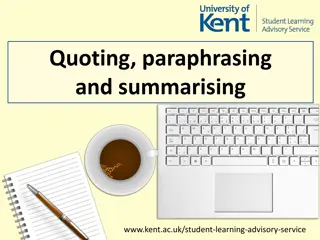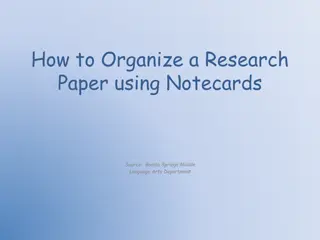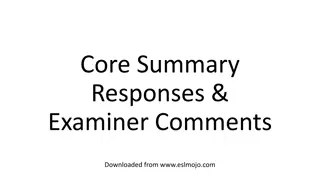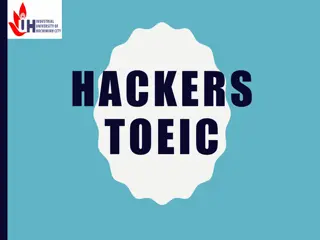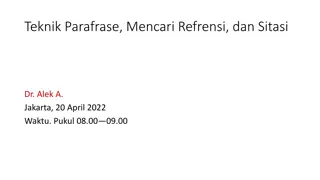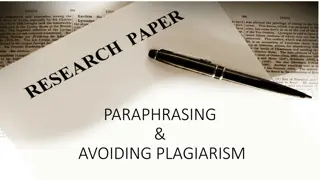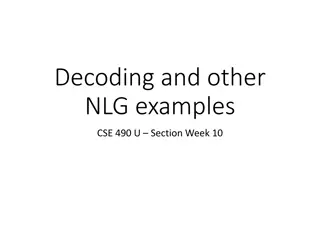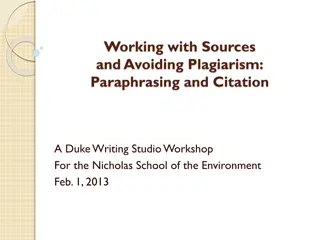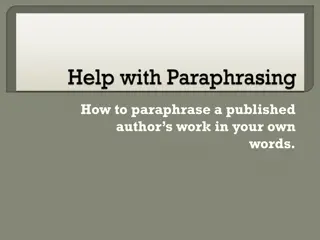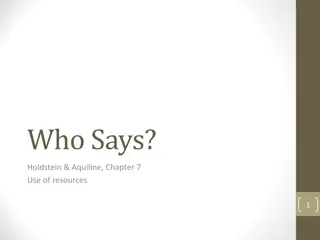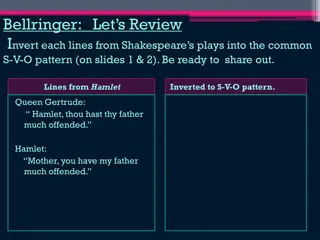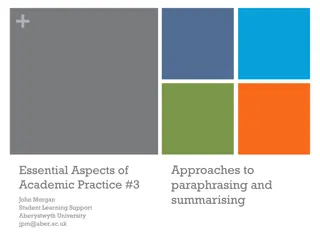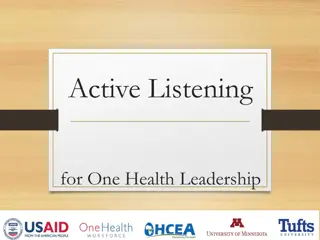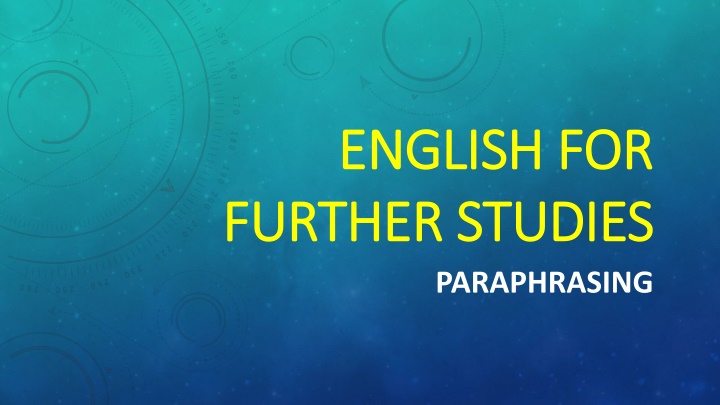
Effective Paraphrasing Techniques for Language Students
Learn the importance of paraphrasing in academic writing, why not to overuse direct quotes, when to use quotes vs. paraphrases, and how to distinguish between them. Enhance your language skills by practicing effective paraphrasing techniques.
Download Presentation

Please find below an Image/Link to download the presentation.
The content on the website is provided AS IS for your information and personal use only. It may not be sold, licensed, or shared on other websites without obtaining consent from the author. If you encounter any issues during the download, it is possible that the publisher has removed the file from their server.
You are allowed to download the files provided on this website for personal or commercial use, subject to the condition that they are used lawfully. All files are the property of their respective owners.
The content on the website is provided AS IS for your information and personal use only. It may not be sold, licensed, or shared on other websites without obtaining consent from the author.
E N D
Presentation Transcript
ENGLISH FOR ENGLISH FOR FURTHER STUDIES FURTHER STUDIES PARAPHRASING
To rewrite or rephrase a sentence in your own words.
To show your range as language students. Shows you understand what you have read. Alternatives to using direct quotes
Why not just use direct quotations? Paraphrasing is more difficult, so why bother to do it?
Students frequently overuse direct quotation in taking notes, and as a result they overuse quotations in the final [research] paper. Probably only about 10% of your final manuscript should appear as directly quoted matter. Therefore, you should strive to limit the amount of exact transcribing of source materials while taking notes. (Source: Lester, James D. Writing Research Papers. 2nd ed. (1976):
When to quote rather than paraphrase You want to add the power of an author s words to support your argument. You want to disagree with an author s argument. You are comparing and contrasting specific points of view. You want to highlight particularly powerful or effective phrases.
Activity Practise distinguishing between quotes, paraphrases and summaries
Answers 1. Statement 1 is a quotation, as it uses the exact words and word order found in the original extract. Normally, when quoting, you would also include quotation marks at the beginning and end of the quote. 2. Statement 2 is a summary. It provides an overview of the main ideas in the extract as a whole. 3. Statement 3 is a paraphrase. It covers the main ideas of the extract, but presents them in new way, using different word order and a different organization of the order of the ideas.
HOW ? HOW ? The student was unable to express the author s main point , despite having read the article several times.
HOW ? HOW ? Change individual words
HOW ? The student was unable to express the author s main point , despite having read the article several times.
HOW ? HOW ? The student was unable to express the author s main point , despite having read the article several times.
HOW ? HOW ? The student was unable to express the author s main point , despite having read the article several times.
HOW ? HOW ? The student was unable to express the author s main point , despite having read the article several times. The student was incapable of expressing the writer s main idea, despite having read the article several times.
WHAT DO YOU THINK? WHAT DO YOU THINK? Is that a good paraphrase?
HOW ? HOW ? The student was incapable of expressing the writer s main idea, despite having read the article several times. Weak paraphrase
HOW CAN YOU DO A BETTER JOB? HOW CAN YOU DO A BETTER JOB? Don t just change the word. Change the word order.
HOW CAN YOU DO A BETTER JOB? HOW CAN YOU DO A BETTER JOB? The student was unable to express the author s main point , despite having read the article several times. Despite having read the article several times the student was unable to express the author s main point.
CHANGE THE GRAMMATICAL FORMS. CHANGE THE GRAMMATICAL FORMS. By changing the form of words( such as verb into noun) Eg: It takes many years to reconstruct the damaged parts. (V) Paraphrase: Reconstruction of damaged parts takes many years. (N)
BY CHANGING THE VOICE BY CHANGING THE VOICE Eg: The government is restricting the registration of private cars to reduce pollution and traffic explosion. Paraphrase: The registration of private cars is being restricted to reduce pollution and traffic explosion.
BY USING SUBORDINATING CONJUNCTIONS SUCH BY USING SUBORDINATING CONJUNCTIONS SUCH AS AS ALTHOUGH , IF , UNLESS , ALTHOUGH , IF , UNLESS , Eg: It is true that team sports often generate unhealthy competition. However, they also create the spirit of cooperation. Paraphrase: Although team sports generate unhealthy competition, they also create the spirit of cooperation.
BY USING SUBORDINATING CONJUNCTIONS BY USING SUBORDINATING CONJUNCTIONS SUCH AS ALTHOUGH , IF , UNLESS , SUCH AS ALTHOUGH , IF , UNLESS , The student was unable to express the author s main point , despite having read the article several times. Even after multiple readings, the student was unable to express the writer s main point.
Change the words Change the order Change the grammatical structure
A part-time job is beneficial for teenagers because it can teach them the importance of being on time.
A part-time job is a good way to teach teenagers punctuality . For teenagers, the importance of time management can be taught by having a part time job .
Studies have shown that over 30% of university students have or copied an essay from an online source.
According to research, three in ten college students have purchased or plagiarized content from the Internet.
Although the dangers of the drug are clear, its popularity continues to rise among teens.
Use of drug among teenagers continues to increase despite the obvious risk
Lets complete the worksheet on paraphrasing
SUMMARIZING SUMMARIZING GETTING TO THE POINT
WHAT IS IT? WHAT IS IT? Short account of the central ideas of a text
WHEN TO WHEN TO SUMMARISE SUMMARISE Summarise when you want to write about the background of a topic, or to give a quick overview of its history. You should also summarise when you want to bring together several researchers ideas about a topic. Hence, summarise when... You want to establish the background to a topic You want to offer an overview of a topic You want to describe common knowledge from several sources about a topic You want to communicate the main ideas of a single source. Again, always remember to reference in-text and end-list.
SUMMARY SUMMARY A good summary is clear to someone who has not read, watched or heard the original source material.
LEONARDO LEONARDO Picture of leo revenant
SUMMARY SUMMARY Revenant is the newest film starring Leonardo Decaprio. In the movie, Hugh glass is badly hurt in a bear attack and is left for dead in the wilderness.
SUMMARY SUMMARY Revenant is the newest film starring Leonardo Decaprio. In the movie, DiCaprio's character, Hugh glass is badly hurt in a bear attack and is left for dead in the wilderness.
SUMMARY SUMMARY A good summary follows a paragraph structure, with a topic sentence stating the title/author/speaker etc.
SUMMARY SUMMARY Revenant is the newest film starring Leonardo Decaprio. In the movie, DiCaprio's character, Hugh glass is badly hurt in a bear attack and is left for dead in the wilderness.
SUMMARY SUMMARY A good summary gives the main points and only the main points. Leave out unnecessary figures, details, etc.
SUMMARY SUMMARY A good summary paraphrases the main points. No direct quotes
SUMMARY SUMMARY A good summary is concise, not wordy.
SUMMARY SUMMARY A good summary is concise, not wordy. (pictures of flowers, unicorn,(magical) shakesphere , deliver the parcel.
SUMMARY SUMMARY A good summary is concise, not wordy. (pictures of flowers, unicorn,(magical) shakesphere , deliver the parcel.
SUMMARY SUMMARY A good summary is concise, not wordy. (pictures of flowers, unicorn,(magical) shakesphere , deliver the parcel.
SUMMARY SUMMARY A good summary is objective
SUMMARY SUMMARY A good summary is objective

